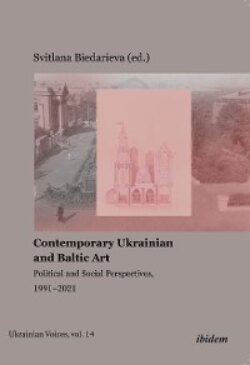Читать книгу Contemporary Ukrainian and Baltic Art - Группа авторов - Страница 10
На сайте Литреса книга снята с продажи.
Conflicting identities
ОглавлениеAn essential part of the complex political and social reality of the region that shaped the contemporary identities of its communities has been the legacy of the Soviet past and its dissonant perceptions. Artists active in the last decade have engaged in mapping, interpreting, and seeking to understand the ways that this legacy has led to scattered histories and memories that remain divided. They revisit complexities embedded in it, looking beyond the selective narrations of this past and foregrounding more nuanced and neglected aspects of the historical context, also confronting nationally driven narratives.
For example, in Latvia and Estonia, where there is still a large Russian-speaking community—comprised of Soviet immigrants from other republics and their descendants8—whose loyalty to the Soviet past and often to today’s Russia is also part of their identity, ethnic issues are still a highly sensitive subject. In this regard, Estonian artist Kristina Norman’s work on the tensions of ethnonational politics, After-War (2009),9 has gained the widest resonance, as it not only exposed the discordant perceptions of the political and memorial clash in Estonia that surrounded the Bronze Soldier, a Soviet “liberation” memorial in Tallinn, but, using artistic means, was involved in the conflict—yet did so without taking sides. The memorial was a highly divisive site: it was a celebration venue for the 9 May Soviet Victory Day over Nazi Germany for many Russian speakers, and thus, a signifier of their identity; meanwhile, for Estonians, it was a symbol of Soviet occupation and repression. As tensions around the monument increased, it was removed from the center to a military cemetery on the city’s outskirts, provoking demonstrations by its defenders and turning into unprecedented and violent street riots and even cyber-attacks on Estonian governmental institutions.
Two years after escalation of this conflict, on the former site of the Bronze Soldier, Norman carried out a public artistic intervention using a life-size replica of the monument—in this way, she tried to approach the polarizing subject matter and articulate that although the problems surrounding the statue and the drama of its relocation were removed from public space, they nevertheless continued to exist. Her action caused an outrage and provoked heated discussions about freedom of artistic expression, power relations, tolerance, and xenophobia in Estonian society. As the artist commented, the reaction to her intervention exploded the sore that was hidden underneath the seeming status quo, revealing the fears that continue to govern that society. From her perspective, the monument was a “symptom of the society’s illness, caused by a nationalist policy that never allowed for an inclusive democratic discussion of such important issues as memory, remembrance, and the political status of ethnic minorities.” (Norman and Elantkowski 2018) In other works, Norman has also discussed the complexity of nationalism, confronting simplistic binarism in order to create space for alternative positions and foster political imagination outside the black-and-white paradigm.
Monuments are symptomatic sites of conflicts between history and memory in their dissonant narrations of the past in a contemporary political context. Identity issues that remain divided in different ethnonational communities were also addressed by Latvian artist Arnis Balčus in his work Victory Park (2014),10 whose documentary and staged photographs formed a visual mosaic, alluding to the complicated postsocialist and postcolonial context of Latvian history and society. Located in the Latvian capital of Riga, at the centre of this park is the Victory Memorial to the Soviet Army, which still gathers a large Russian-speaking non-citizen community on 9 May. For Latvians, it is a symbol of Soviet totalitarianism, and thus it is also emblematic of the radically different interpretations of history by these different parts of society.
However, the historical layers of the park are much denser, and it can serve as a brief summary of the turbulent history of Latvia in the twentieth century. Created at the beginning of the twentieth century, as Riga Petrovsky Park, it celebrated the bicentennial anniversary of the accession of Riga and the Governorate of Livonia to the Russian Empire. In the 1920s, the park was renamed “Victory Park” in honor of the Latvian War of Independence. In the 1930s, during the regime of authoritarianism, it was ambitiously reconstructed, planning to build a monumental stadium for military parades, the Song Festival, and other mass events that would symbolize the greatness of the independent state. The Park is also a reminder of Nazi history—in 1946, it was the site of the last state execution in Latvia, when Soviet authorities publicly hanged several German officers for their war crimes. In the 1960s, the park was renamed after the 22nd Congress of the Communist Party of the Soviet Union—in honor of the event in which Khrushchev denounced Stalin’s crimes and declared plans to build communism in twenty years. The Soviet Victory monument in the park was unveiled in 1985, shortly before crucial Soviet reforms such as glasnost and perestroika.
These dense layers of the past in Balčus’s photographs were referenced as a vaguely allusive context—scenes, taken in the park and its surroundings, depicted the 9 May celebrations, portraits of war veterans, landscape details, erotic pictures, and everyday motifs, seemingly unrelated to history or ideology. Formed as a hybrid combination of documentary photography and artistic experiment, the work was more an impression than a description of this complicated past. The artist deliberately left open the possible interconnectedness of the images, emphasizing that this non-linear, multi-layered, and ambiguous photo-story uncovers the entwined relationship between the power, memory, trauma, and desire behind which the unresolved tensions of post-communist society lie. Similarly to Kristina Norman, Balčus commented that this trauma is only a symptom of the disease, the cause of which is much deeper or even unconscious.
